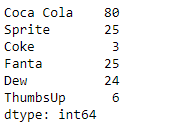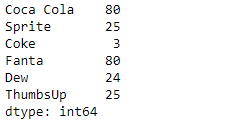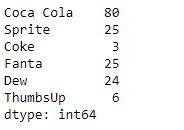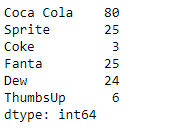Python Pandas Series.equals()
Pandas系列是一个带有轴标签的一维ndarray。标签不需要是唯一的,但必须是一个可散列的类型。该对象支持基于整数和标签的索引,并提供了大量的方法来执行涉及索引的操作。
Pandas Series.equals()函数测试两个对象是否包含相同的元素。这个函数允许两个系列或DataFrame相互比较,看它们是否有相同的形状和元素。
语法: Series.equals(other)
参数:
other:要与第一个系列或数据框架进行比较的其他系列或数据框架。
返回:如果两个对象中的所有元素都相同,则为真,否则为假。
例子#1:使用Series.equals()函数来检查两个给定的系列对象中的基础数据是否相同。
# importing pandas as pd
import pandas as pd
# Creating the first Series
sr1 = pd.Series([80, 25, 3, 25, 24, 6])
# Creating the second Series
sr2 = pd.Series([80, 25, 3, 80, 24, 25])
# Create the Index
index_ = ['Coca Cola', 'Sprite', 'Coke', 'Fanta', 'Dew', 'ThumbsUp']
# set the first series index
sr1.index = index_
# set the second series index
sr2.index = index_
# Print the first series
print(sr1)
# Print the second series
print(sr2)
输出 :


现在我们将使用Series.equals()函数来检查两个给定系列对象中的基础数据是否相同。
# check for equality
result = sr1.equals(other = sr2)
# Print the result
print(result)
输出 :

正如我们在输出中看到的,Series.equals()函数返回了False,表明两个给定的系列对象中的元素是不一样的。
例子2:使用Series.equals()函数来检查两个给定系列对象中的基础数据是否相同。
# importing pandas as pd
import pandas as pd
# Creating the first Series
sr1 = pd.Series([80, 25, 3, 25, 24, 6])
# Creating the second Series
sr2 = pd.Series([80, 25, 3, 25, 24, 6])
# Create the Index
index_ = ['Coca Cola', 'Sprite', 'Coke', 'Fanta', 'Dew', 'ThumbsUp']
# set the first series index
sr1.index = index_
# set the second series index
sr2.index = index_
# Print the first series
print(sr1)
# Print the second series
print(sr2)
输出 :


现在我们将使用Series.equals()函数来检查两个给定系列对象中的基础数据是否相同。
# check for equality
result = sr1.equals(other = sr2)
# Print the result
print(result)
输出 :

正如我们在输出中看到的,Series.equals()函数返回True,表明两个给定的系列对象中的元素是相同的。
 极客教程
极客教程